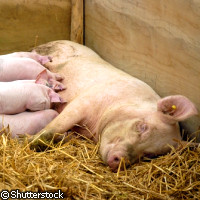Using genetics to boost piglet survival
EU-funded researchers have improved the survival rates of newborn piglets in just one generation by applying simple selective breeding techniques. The scientists hope their findings will lead to a reduction in use of the farrowing crate, a metal cage that has been widely criticised by animal welfare groups. Neonatal mortality is a serious problem for pig farmers: on average 20% of piglets per litter die. This is not just an animal welfare problem; at current prices, early piglet deaths would cost a farmer with 250 sows over €50,000 per year. At the moment, farrowing crates are commonly used to prevent sows from accidently crushing their piglets. The cages effectively separate the mother from her young, which are only able to reach her teats to feed. However, farrowing crates are known to cause stress to the sows, and are also implicated in other causes of piglet mortality such as savaging. Unsurprisingly, farrowing crates have been the focus of a number of public animal welfare campaigns. In this study, researchers turned to genetics to see if selective breeding could improve the survival of piglets in loose-housed or outdoor systems. Their investigations revealed that piglets that find the udder and suckle quickly have better survival rates. Piglets with a good body shape and a good covering of fat are also more likely to survive. The sow's characteristics also influence piglet survival. In the womb, piglets that are provided with an efficient placenta are more likely to have a good birth weight and survive. Once the piglets have been born, sows that show good maternal behaviour also boost the survival chances of their young. A good mother is one that remains calm during birth and lies down carefully to reduce the risk of crushing her young. The researchers studied piglets and sows born to fathers with high survival rates and compared them to newborns fathered by average survival boars. They found that mortality in the litters fathered by high survival boars fell to 12%, compared to 18% in the other group. Sows from high survival litters also tend to be better mothers, displaying less crushing behaviour than their counterparts from average survival litters. The researchers highlight the fact that the benefits of selective breeding in this way can be seen in just one generation. 'Improving survival using genetic selection strategies benefits both piglet and sow welfare, as well as assisting the farmer by making substantial economic savings,' the researchers state in a factsheet on the subject. 'Additionally, this research demonstrates the potential for phasing out of the farrowing crate in the future.' EU support for the research came from the Welfare Quality project, which is financed to the tune of € 14,400,000 by the 'Food quality and safety' Thematic area of the Sixth Framework Programme (FP6). The Welfare Quality project aims to develop practical strategies to improve the welfare of farm animals as well as methods to communicate animal welfare information to consumers. Other factsheets produced by the project address lameness in dairy cows, social stress in cattle and health problems in broiler chickens.



